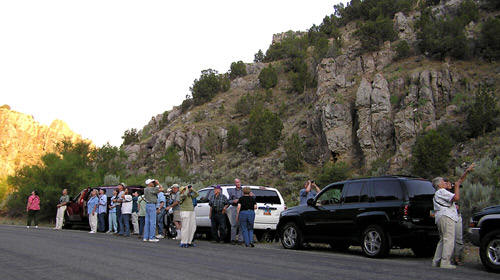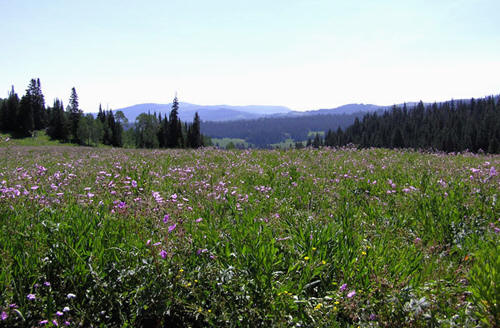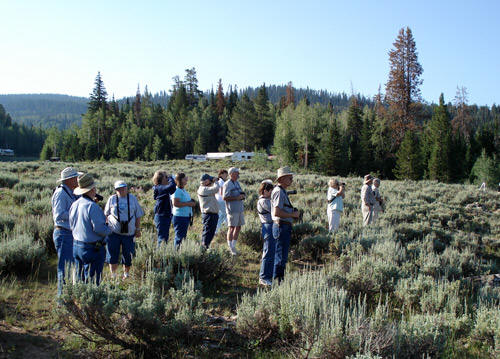Utah County Birders Newsletter
August 2006
Contents
August Meeting
Upcoming Field Trips
Feather Talk
Field Trip Report
- Mona Area - July 12th, 2006
Field Trip Report
- Soapstone Area - July 22, 2006
Backyard Bird of the
Month
July Hotline
Highlights
AUGUST MEETING:
Wednesday, August 9th
Pot Luck, Summer Social - Meet at 6:30 PM
at Carol Nelson’s house - 2831 Marrcrest West, Provo.
Pot Luck -- bring a salad, vegetables/fruits, or dessert. Meat, plates and
utensils will be furnished.
Program - Middle East Birding - Landon Jones
will show us a Power Point presentation about birding in the world's current
"hot" spot.
Turn West off University Ave at 2900 North (Marrcrest), Carol Jean’s place is on
the west side of Marrcrest circle.
FIELD TRIPS:
Saturday, August 26th
We will travel north to meet with our trip leader Glen Barlow in
Kaysville. He will take us to shorebird places in SL &
Davis counties. Meet at the Orem Center Street Park & Ride at 6:00
a.m.
Don't forget - August 17th - 19th: Western Birding
Symposium - Utah Ornithological Society Fall
Conference -
Click here for
Details.
Feather Talk
By Alton Thygerson
Ticks
The last thing I want to do is make anyone paranoid about going out to enjoy
birds in natural habitats. Birders ought not sit indoors fretting about their
chances of contracting a disease from ticks. Armed with a little DEET and
knowledge about how to recognize and remove ticks, there's no reason why you
can't venture out to pursue yet another new bird for your life list.
I’ve had a couple of bird-related encounters with ticks. Several years ago after
being on the Deseret Ranch for several days of birding, I came home and while
showering the “ranch” off of me, I felt a small bump on the back of my thigh.
Close inspection found that it was an embedded tick.
This spring I birded one day on the famous Texas King Ranch in pursuit of the
Ferrugenous Pygmy-Owl. The guide suggested that we do a tick check, so that
evening I found three ticks—two embedded in my skin and one crawling around
looking for a good spot to sink its mandibles into my skin.
A tick crawls around on its unsuspecting host (humans, deer, mice, etc.) on
eight tiny legs looking for the right spot to settle down for a few days. With
pincer-like organs, it digs a small wound in the host. Into the wound goes a
feeding apparatus called a hypostome; its powerful sucking mechanism allows the
tick to feed on the blood of the host. Anchored firmly in the wound, it feeds
for an average of two to five days and drops off. Some ticks increase in size 20
to 50 times more than when it first arrived. In the host it often leaves a
reminder of its visit—a disease-causing microorganism. Worldwide, only the
mosquito spreads more illness to humans than a tick.
Tick Removal
Some of you may know that I write first aid and emergency care books. One of my
recent publications is: Wilderness First Aid Field Guide published by
Jones and Bartlett Publishers (see Amazon.com or a local bookstore can order
it). It was reviewed and endorsed by the American Academy of Orthopaedic
Surgeons, one of the premier medical organizations in the world. Its pages are
waterproof.
The field guide uses decision tables to identify “what to look for” and “what to
do.” Here’s what the field guide says about removing an embedded tick:
1. Use tweezers or a specialized tick-removal tool to grasp the tick close to
the skin and lift it up to “tent” the skin’s surface. Hold until the tick lets
go, or after about one minute, then pull tick away from the skin. DO NOT jerk or
twist the tick. Any remaining mouthparts do not transmit disease and will
usually be expelled later.
2. Wash the area with soap and water.
3. Disinfect the area with rubbing alcohol.
4. Apply an ice pack to reduce pain.
5. Check for a rash for one month. Watch for others signs such as fever, muscle
aches, sensitivity to bright light, and paralysis that begins with leg weakness.
If any of these appear, seek medical care.
6. Save the tick if you would like to have it checked for disease. Make note of
the time and your location with the saved tick.
Cautions:
Research by Dr. Glen Needham of Ohio State University found that these methods
are ineffective for removing ticks:
• DO NOT use fingernail polish
• DO NOT use rubbing alcohol.
• DO NOT use a hot extinguished match head.
• DO NOT apply petroleum jelly.
• DO NOT apply gasoline.
• DO NOT use bare fingers
Quick removal is necessary to reduce the chance of disease transmission. The
longer an infected tick stays embedded; the greater the chance for disease
transmission.
Prevention of Tick Bites
The field guide also contains way of preventing becoming tick bitten. The
methods include:
1. Avoid tick-infested areas, when possible.
2. In tick-infested areas stay in the center of paths, avoid sitting on the
ground, and check clothing.
3. Dress properly:
• Wear light-colored clothing so that ticks can be seen more easily and removed
before becoming attached.
• Wear a long-sleeved shirt that fits tightly at the wrists and neck, and tuck
your shirt into your pants.
• Wear long pants; tuck pant legs into tops of socks or use masking or duct tape
to secure pant legs tightly to socks, shoes, or boots.
4. After coming indoors, shower or bathe. Look and feel your entire body for
ticks, especially in areas that have hair or where clothing was tight. Have a
companion or use a mirror to check the scalp, behind and in the ears, neck,
back, and behind the knees. Such a tick check of all parts of the body should be
done at least twice daily when traveling in tick-infested areas.
5. Use chemicals:
• Apply insect repellents containing EPA-approved DEET to clothes and exposed
skin. Avoid high-concentration products (more than 30% DEET) to the skin. Do not
inhale or ingest DEET-containing products or get them in your eyes. Do not use
products with more than 10% DEET on children under five years of age.
• Apply 0.5% permethrin (kills ticks on contact) only to clothing and not the
skin. Apply according to label instructions. Applications to shoes, socks,
cuffs, and pant legs are most effective against ticks.
Most tick bites are harmless, although ticks can carry Lyme disease, Rocky
Mountain spotted fever, Colorado tick fever, tularemia, tick paralysis, and
other serious diseases.
Bottomline: if you are prepared, you should not fear.
Field Trip Report
Mona Area - July 12th, 2006
by Glenn Barlow
 |
|
Utah County Birders in Goshen Canyon
photo by Eric Huish |
It Was a 3-Owl Night.
On Wednesday evening a group of Utah County birders met at the Payson Park and
Ride, near I-15, and birded the southern part of Utah County and the northern
part of Juab County, near Mona. This is by no means all the birds that were
seen, but at least most of them. It seems that there were about 7-8 carloads of
people, perhaps more. We started up Goshen Canyon and went south.
In Goshen Canyon we had great looks at a Canyon Wren, Yellow-breasted Chat, and
some other usual birds, including a fly-over by a Peregrine Falcon.
Our trip ended at dark with a great view of a Ferruginous Hawk, a Swainson’’s
Hawk, several Short-eared Owls, and Burrowing Owls in the fields west of the
road south to the city Mona, just east of the reservoir. There were lots of
Common Nighthawks in the wetland marsh area south of Mona Lake, leading to town.
As we took the old highway north Dennis stropped when he spotted some Barn Owls
flying into some trees on the east side of the road.
A list of birds seen included the following:
Utah County
Payson: Barn Swallow
Goshen: Common Nighthawk, Eurasian Collared
Dove, Mourning Dove.
Goshen Canyon: Chukar, American Robin, Golden Eagle,
Yellow-breasted Chat, Peregrine Falcon (flying over mountain to east),
Black-billed Magpie, Rock Pigeon, Great Blue Heron (flying over the canyon
toward Utah Lake), Canyon Wren.
Juab County
South of Goshen Canyon: Spotted Towhee, American Towhee, Northern
Harrier, Ferruginous Hawk, Short-eared Owl, Swainson’s Hawk, Burrowing Owl, Lark
Sparrow, Mourning Dove, Common Raven, American Coot, Killdeer, American Avocet,
Mallard, Willet, Black-necked Stilt, Yellow-headed Blackbird, Black-crowned
Night Heron, Barn Owl.
Field Trip
Report
Soapstone Area - July 22, 2006
by Carol Nelson
It's always good to see a master at work, and on Saturday, July 22nd twenty
birders had that opportunity when Merrill Webb helped us escape the high
temperatures in the valley by introducing us to the Soapstone basin and
surrounding areas in the Uintahs. We common folks marvel at Merrill's ability to
identify almost anything quick of wing in the sky, or on a distant perch. The
true wonder to me, however, is that our scopes prove him to be correct on his
machinegun identification.
Now the question arises: If he can identify it on the fly and I see the bird but
have to rely on his identification, is it right for me to count it on my species
list? We discussed this in our car and came up with three possibilities. First,
the harsh method, if you can't see its identifying characteristics, you can't
count it. Second, the BYU student's method, if you hear the name pronounced
clearly you may count it. (For some of us who lean towards the deaf side that
one is even a challenge.) Third, the friendly method, if someone sees the bird
and you look at its picture in the field guide and touch the person who saw it,
for goodness sakes count it! I suddenly feel my life list growing.
Not only does Merrill identify, he produces. I was happy to add five new birds
to my species count for the year. Give or take a few individual sightings, the
following species were seen:
 |
|
Wildflowers were in full bloom
everywhere we went
photo by Milt Moody |
 |
|
Utah County Birders on the Soapstone
Trip
photo by Glenn Barlow |
Red Crossbill
Pine Siskin
Three-toed Woodpecker
Hairy Woodpecker
Olive-sided Flycatcher
Northern Flicker
Willow Flycatcher
Red-naped Sapsucker
Brewer's Sparrow
Chipping Sparrow
Vesper Sparrow
Song Sparrow
Lincoln's Sparrow
White-crowned Sparrow
Green-tailed Towhee
Cedar Waxwing
Mountain Bluebird
American Robin
Ruby-crowned Kinglet
Mountain Chickadee
Yellow Warbler
Cliff Swallow
Black-billed Magpie
Common Raven
Warbling Vireo
Mourning Dove
Spotted Sandpiper
Sandhill Crane
Cooper's Hawk
Sharp-shinned Hawk
Swainson's Hawk
Red-tailed Hawk
American Kestrel
Turkey Vulture
If you don't have the privilege of going birding with an expert like we did, no
matter, just open your book and start touching people.
May your life list continue to grow.
Backyard Bird of the
Month
July 2006
Alona Huffaker - Springville
About Seven Evening Grosbeaks flew over and landed for just a few
seconds--not even enough time to get Bonnie from next door out to see them.
Eric Huish - Pleasant Grove
Cliff Swallows - I like to lean back on a chair and watch the swallows
fly over.
Milt Moody - Provo
Black-headed Grosbeak - young birds exploring my yard and chowing down on
my sunflower seeds.
Bruce Robinson - West Jordan
Boreal Chickadee - I cheated--brother in law's backyard in Alaska.
Tuula Rose - Provo
A pair of Black-headed Grosbeaks amongst a lot of nervous young house
finches.
Bonnie Williams - Mapleton
Western Scrub-Jay - Came to my new peanut feeder.
We would like you to share your favorite backyard bird each
month. Please send your favorite bird at the end of the month to
newsletter@utahbirds.org or call 360-8777. If you would like a reminder at
the end of the month e-mail the above address.
|


